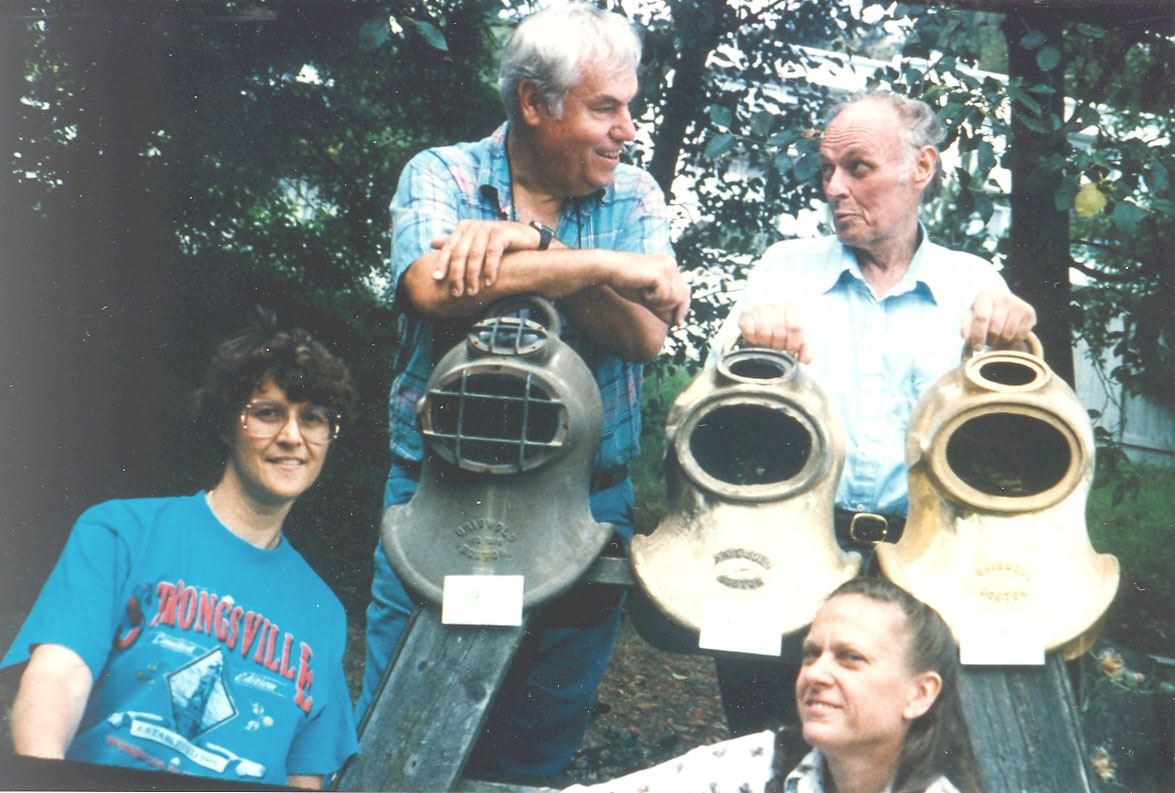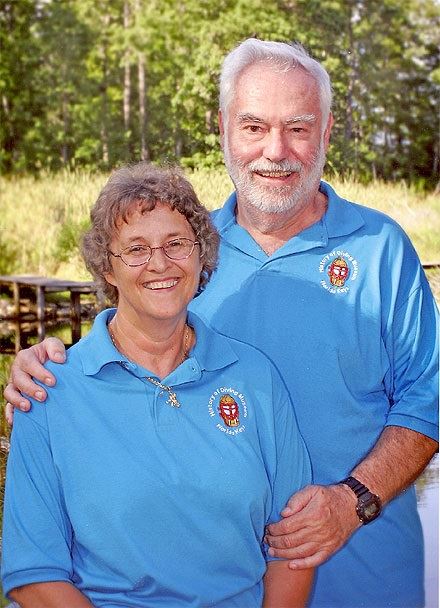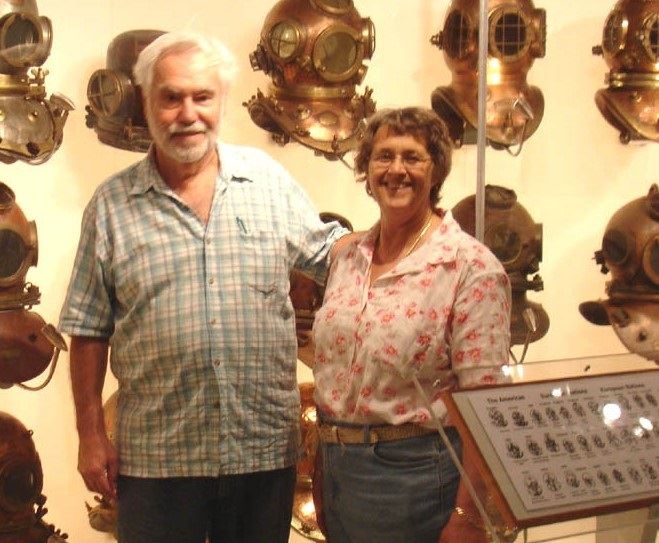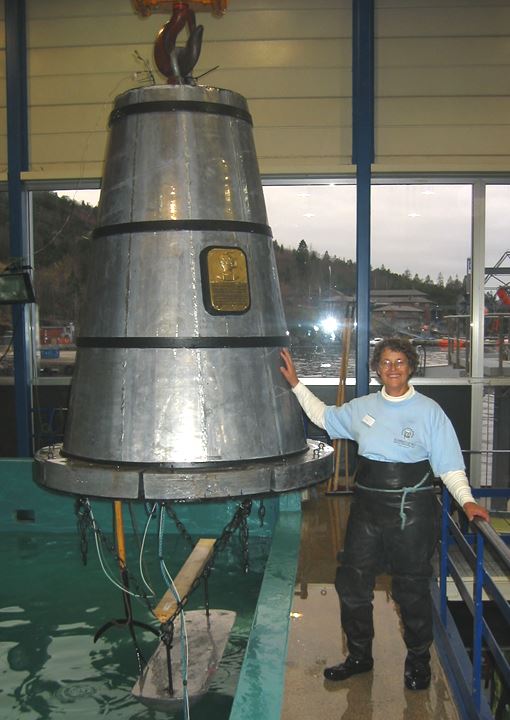|

SALLY BAUER
Drs. Joe and Sally Bauer opened the History of Diving Museum which features a one-of-a-kind diving helmet display of helmets representing nations from around the world.
When they took their mothers to Europe in the early 1970s, the Bauers stopped at the Science Museum in London. They thought it was pathetic that the inventor of diving in England was highlighted in a minimal display. However, there they discovered their love of books which is commemorated by the Joe Bauer Research Library today. Opened in February of 2012, it houses more than 2,500 books, prints and photographs about the history of diving and is the largest collection of historic and rare literature of diving history in existence. "It was like a religious experience,” said Sally of their research in London. “We spent several days in the patent office, going into a low-ceilinged vault, taking out books from the 1600s and reading them in dimly-lit stacks.” They took photos of pages that interested them. This adventure cemented the desire that diving history forever more was to be part of their vacations. They later explored Hamburg, Germany and Yokohama, Japan with that in mind; however, it was fortunate to start in England because language was not a barrier. When they traveled, they left their name with store owners who carried old books, wood cuts, prints or antiques. They told the owners if something related to diving came into the shop, they were interested. Touring with the British Diving Organization, they went to the building where in the 1870s Augustus Siebe, a German-born British engineer, developed and manufactured diving and breathing equipment and worked on commercial diving and marine salvage projects. Siebe produced his own helmet design, one of which is in the Islamorada museum, with a valve fitted to a full-length watertight canvas diving suit. Siebe’s helmet also is the logo of the Historical Diving Society, which says the “designs incorporated in Siebe’s equipment provided a safe and efficient means for divers to work under the sea. It was the Siebe helmet design and its accompanying apparatus that launched the trade of the diver.” Through the Historical Diving Society, Bauer became the first American woman to “suit up” and dive in Portsmouth, England -- where Navy divers practiced their trade -- wearing the historic Siebe equipment. It weighed 100-200 pounds, she said. “I could hardly lift my feet.” She shuffled to the water, but since the equipment hadn’t been made snug by the British tenders helping her, the helmet fell over her eyes. “One size did not fit all,” she mused. Somehow, despite being covered from head to toe, she let them know she needed help, and after receiving help, soon backed down the ladder into the dark depths in this extraordinary diving apparel. Underwater, she could hear the hiss of air from her helmet, and reveled in this singular experience. When Siebe expanded his factory, he moved it to CBRYWM, Wales. The Bauers went in search of the address and thought the letters they had was a postal code, so they stopped at a local police station to ask for directions. It turned out the Welsh language does not incorporate many vowels, so in reality, they had the name of a town. They found the factory, which had become a museum heralding Siebe. When the Bauers went to Paris, they spent all their time in the patent area of the library, in part researching French native, Dr. Manuel Théodore Guillaumet, who, in 1838, invented a twin-hose demand regulator.
| Most Islamorada residents driving the Overseas Highway can’t miss the History of Diving Museum (https://divingmuseum.org/) with the largest underwater mural in the Keys painted on the side of its building depicting treasure diver, Art McKee, and numerous sea creatures. The History of Diving Museum, the life’s work of Drs. Joe and Sally Bauer, first opened to the public on a part-time basis in September 2005. For the next 12 months, the museum installed a new exhibit monthly, opening each exhibit with a lecture and tour. The museum began full-time operation in September 2006 and is open daily from 10 a.m. to 5 p.m. *** Doctors Joe and Sally Bauer unknowingly embarked on a decades-long treasure hunt during a shopping trip in 1967-68 that led to worldwide travel and research to find diving artifacts to tell the history of diving house in their new diving museum. In 2005, the Islamorada residents opened the Florida Keys History of Diving Museum featuring the world’s largest collection of historic diving helmets. Joe passed away suddenly in early 2007, but the story of diving had to be told. See how Joe affected positively both the medical world and the historical record of diving during his life here. Housed in a converted storage unit building at Mile Marker 83, the constantly-changing museum has intrigued visitors for the past 16 years. Dr. Sally Bauer, a retired emergency room physician, serves as treasurer for the History Preservation Society of the Upper Keys and on the Mariners Hospital Board of Directors as well as overseer of the museum. She was inducted into the Women’s Diving Hall of Fame in 2011 and currently serves on its board. The Hall of Fame is dedicated to recognizing and honoring the contributions of women divers. Bauer, president and co-founder of the History of Diving Museum, also is a founding member of the Historical Diving Society. She lectured and published articles on diving history, marine biology and aquariology. With her husband, she conducted a 30-year research project on angelfish reproduction and social behavior. Diving since the late 1960s, Sally earned her certification in underwater medicine as an adjunct to her work as an emergency room physician in Ohio. More recently, at the museum, she established the Joe Bauer Research Library to provide a resource for diving history scholars. It houses an international collection of rare and precious books and resources. The Bauers had high-stress jobs as doctors; Joe was a surgeon. The couple found they could get away from the stress by going under water, so diving became a huge part of their lives. It was relatively easy to fly from Ohio to the Florida Keys, where they did frequent dives and looked for angelfish to record their social and reproductive behavior. During one trip, they stopped at a “dirty” antique shop near the Miami airport on East River Road. “Stone Age Antiques, more like a junk shop, is run by an irascible old man,” said Bauer. “He had everything. If you needed an axe, shovel, polar bear, he had it. It still is there today.” In one section, the Bauers spied an old diving helmet. Although it was expensive, $500, in 1967-1968, the Bauers had to have it. “We thought it would be a good conversation piece.” It’s currently in the museum’s changing exhibit room. That helmet helped launch Historical Diving Society USA, an educational, non-profit whose mission is “to preserve, study, compile, archive and disseminate information relating to the history of human underwater activities and to promote public awareness of and participation in underwater activities.” It became the Bauers’ passion. The Bauers went to libraries and patent offices to dig for information on the history of diving, and believed it was important to gather and chronicle this information. They put a lot of legwork and air miles into this effort.
 No language other than French was allowed in its Naval Library, but luckily Joe was multilingual. There were other quirks they contended with in France. Since the Bauers had the same surname, they were considered one researcher rather than two, and could only check out five books at a time. Rather than say au revoir, “We kept returning,” Sally said. “The joy of collecting in our early days was the hunt,” she said. “Now with eBay, the hunt is gone.” When they went to Trieste, Italy the Bauers were in search of a child’s diving helmet. Trieste also was home to the National Museum of the U.S. Navy which featured the first deep submergence vehicles. They also visited the Diving Museum in Ravenna, home of the Italian Historical Diving Society. There, in an old warehouse, they saw the mold and a woodcarving “gray like driftwood showing the aging of time” used as a model to create the Christ of the Deep statue, Bauer said. One Christ of the Deep statue, a gift from Italy, rests on the sea bottom near John Pennekamp Coral Reef State Park in Key Largo. When the Bauers traveled to Montreal, Canada, their quest was John Date diving equipment. The company was founded in Montreal in the mid-1800s initially as a dive equipment repair company and later as a designer and manufacturer of his own helmets, along with dive-related gear. Many of his design elements were innovative and were copied by other diving helmet manufacturers. The Bauers tracked down the daughter who had grown up playing with the helmet, and who spoke only French, and who gave them a precious book from her father. In the late 1980s, the Bauers visited the Truk Atoll, now called Chuuk Lagoon, in Micronesia. Their research was overseen by armed guards. Due to World War II, the area houses a watery grave, full of bones and skulls, said Sally. They met with the governor who showed him an American Mark 5 diving helmet housed in his office, still accompanied by the guards. One final escapade Sally shared was to City Island, N.Y. to visit the North Wind Undersea Institute, founded by ’60s rocker Richie Havens and former Navy SEAL Michael Sandlofer. It houses old scrimshaws, whale and shark bones, a 100-year-old tugboat and rare sea animals. It was on that trip that the couple found the “Iron Mike” diving suit, originally a rusty, gray-brown color and now a stunning yellow; as well as a 3,000-pound anchor and cannon originally salvaged from the Winchester by Art McKee and now home in the Keys where it was discovered originally beneath the sea in the 1940s. This fascinating lifetime of adventures and collecting got its start in a Miami antique store. “It all started with that first diving helmet,” Sally said. |





